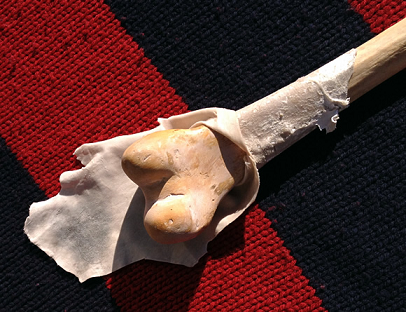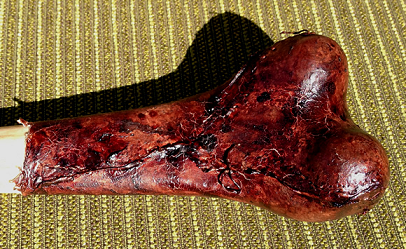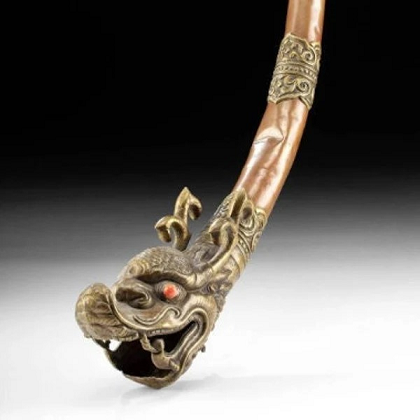| Home » » 殘暴的偽藏傳佛教、西藏密宗、喇嘛教殺人證據 |
取人骨標准嚴苛——密宗是全球唯一發明人骨笛kangling的現存宗教和邪教 |
(圖示:這是一件古老的人骨笛。人骨笛,多取材大腿骨——股骨,近髖關節處的一端會被切除而保留靠近膝關節的股骨髁。 因為股骨髁多為骨松質,在干燥之後結構更為疏松、不耐碰撞,所以喇嘛們會使用動物真皮、動物肌腱為縫合線、金屬銀或錫等進行包覆。 更有甚者,以紅瑪瑙和綠松石進行裝飾,以彰顯喇嘛教法器的尊貴,實為殺戮戰果的殘忍!) 人骨笛,有一個很好聽的名字—kangling(常譯為:康靈或剛令等),然而以其取材和製作來探究真相,卻極其殘酷。 人皮鼓、人皮唐卡、活采肉蓮、活摘的少女乳頭,如果這些都是從天葬台那些亡者身上取來的,也許可以勉爲其難地接受,然而真相是:密宗上師喇嘛們不屑於取用已經死亡之人的器官;那麼如果是自然衰老的,他們肯定不喜歡那皺巴巴、色素沉著的老皮,和那脫鈣的、骨質疏鬆的、顏色暗沉的老骨頭;如果是病死的他們又會嫌棄那有疾病而不吉祥,似乎殺死一個健康活人取材倒成了很吉祥的事情;意外事故死亡的又少且可遇不可求......反正橫著算、竪著算,那個年代人類死亡的方式無非如此三大類而已。 人皮鼓,是從供體尚處於兒童時代就已經物色好了,把兒童人工加工成聾啞人,待到成爲少女時就是獻祭、取材製作法器的「神聖」時刻了。可見,密宗對於製作法器的素材可是要求極爲嚴苛的,「神聖」二字,其實他們不配使用! 人皮鼓既然如此,那麼人骨笛呢? 以下引用和簡譯國外售賣人骨笛的專業網站的專業描述: 骨製號角或稱康鈴,以其哀嚎和怪異的聲音,體現了施身法儀式所營造的超凡脫俗的氛圍。它是由人的大腿骨製成(藏語:kang=腿,ling=笛子),是一種非常特殊『且非常神奇』的樂器。乍一看,人們可能認為康林教是從喜馬拉雅薩滿教或佛教傳入西藏之前的古老苯教吸收而來。事實上,這兩個較古老的傳統都沒有使用過股骨號角。(版按:此處説明薩滿教和苯教並沒有使用同類的骨頭和器官製作法器的傳統,這樣殘忍的技能來自於密宗,是密宗,印度教密宗或是西藏密宗的發明。)人體的長骨形成天然的棍棒或其他器具,但與西方文化一樣,古代社會不會隨意使用人類遺骸。事實上情況恰恰相反,祖先的骨頭要不是被視為崇敬的聖物,就是被視為嚴格的禁忌。此外,動物的骨頭、筋腱和角也很容易取得,有各種實際用途。
事實上,施身法器是一千五百年前在印度密宗熔爐中誕生的一套神聖法器的一部分。在那裡,濕婆教派和佛教的瑜伽士和瑜伽女都過著雲遊苦行的生活,住在屍陀林附近,佩戴骨製飾品,並使用一組獨特的儀式用具,其中包括人顱杯。密宗儀式中所描述的神靈所佩戴的相同物品也出現在當時的大寺院中,既因為它們具有深刻的像徵意義,也因為它們具有內在的精神力量。佛教密宗和生活方式「金剛乘」於西元 800 年左右開始傳入西藏,而康林則在接下來的一個世紀出現在喜馬拉雅地區。然而,只有隨著Machik和施身法(chod)的發展,我們才看到股骨成為一種重要且廣泛使用的儀式工具,對於席捲西藏肥沃的山谷和荒涼的山脈的輝煌的新形式的精神修煉至關重要。
各種文本和口頭傳統都描述了 Chod kangling 的最佳來源,它是我們供奉的載體。因此,最完美的樣本應該是婆羅門兒童,無論男女,沒有世俗的污點或缺點。(版按:此處所要求的沒有任何污點與缺點,與西藏密宗挑選皮膚完好的女童活剝人皮製成人皮鼓如出一轍。這樣的兒童,沒有先天缺陷卻要自然死亡並不是件容易的事情,而生病死亡又不是他們所能接受的重大瑕疵。所以,您認爲這樣的素材是如何取得的呢?)另一方面,它不應該來自死於肺結核、瘟疫或其他傳染病,或某些事故或不幸的人。(版按:事故死亡的屍體他們也是不要的。在古代醫療資源匱乏,在老死之外,如果還會造成人死亡,往往就是肺結核、瘟疫之類的重大疾病和傳染病。這些又都是密宗製作人骨笛所摒棄的材料。那麼,密宗製作人骨笛的素材到底是如何取材的?誰能給末學一個接近真相的、也許震驚世人的答案?)死於年輕時頭腦清醒的人的右腿被認為是“達卡康林”,具有開悟的男性能量。 來自類似個體(男性或女性)的左腿是空行康林,具有開悟的女性能量。具有微妙的品質,而以同樣方式死去的壯年女性的右股骨也具有優良的品質。(版按:此句年輕時頭腦清醒的人的右腿被認為是「達卡康林」,具有開悟的男性能量,左腿是空行康林,具有開悟的女性能量,顯示密宗認爲製作人骨笛的最佳素材,是年輕和頭腦清醒的男女。年輕人,正是生命力旺盛的時候,如果不是意外事故和重大瘟疫,怎麼會死亡呢?耐人尋味啊!另外,密宗對於同類的骨頭竟然也可以投射出如此強烈的執念:佛門開悟的機緣和自己的身體都幾乎沒有什麼瓜葛,除了用來參禪和觀行,別人的活人骨頭或是死人骨頭,又豈能助人開悟!真是天大的笑話!)如此重要的遺物自然會傳給適當的繼承人或宗族持有者。 如果使用父母或親屬的骨頭,這將為死者在來世積累巨大的功德或積極的業力,儘管在現代背景下這樣的樣本很難獲得。在其他施身法傳統中,一位年輕母親在分娩時去世,但她的孩子卻活得極為吉祥;這塊骨頭的能量充滿了對孩子深沉、專一的愛與犧牲的思想。(版按:母親也許是難產死亡,那父親呢,難不成也難產?明明人家父子、母子可以共同生活享受天倫之樂,把人家父母殺了製作人骨笛,倒反過頭來詭辯說這樣的作爲可以為孩子帶來吉祥。上師從來不殺自己為親眷帶來吉祥。)其他人則認為,無論上述所有考慮如何,無論是出於解剖學還是精神方面的原因,女性的骨頭發出的聲音都更清晰。(版按:密宗上師鍾情於女性的骨頭,也必定使用過許多人骨,才注意到女性的骨頭發出的聲音更清晰。) 如果沒有這些特殊特徵,一般來說,這根股骨至少應該來自年齡在16-60歲之間的人,並且來自「純淨」的墓地。當然,今天我們很難知道這間康玲的起源和歷史,以及它以前的主人。
一些傳統認為用虎骨或禿鷹骨製成的康靈是非常吉利的,但在其他地方,人們對此並不贊同。號角是一種全金屬、銅或黃銅製成的,也簡稱為康林,用於各種密宗儀式,如憤怒的本尊和護法神儀式,以召喚或宣告神靈的兇猛和強大的存在。和Chod kangling一樣,它們的用途僅限於音樂標點和重音,而不是伴奏。然而,它們的聲音音調更高,而且更加強烈和刺耳。但這種銅號在施身法中從來不用。還有「混合」股骨,其大端覆蓋有華麗的金屬製品,由銀或「白色金屬」(鋁合金)製成。再次強調,這些都是為了消除或移除障礙而進行的憤怒修行的一部分。這種混合體並不適用於 Chod,尤其是因為金屬頭通常會隱藏受損或缺失的股骨髁。 MaChik 特別警告不要使用任何由動物角製成的喇叭(薩滿和民間流浪醫師使用的那種),因為它會給使用者帶來許多負面副作用。然而,敏珠林手冊提到,在施身法儀式中使用羚羊角或鹿角的傳統已在某些學校和老師中廣為流傳。此外,據說它還能激發獵人和漁民的同情心,增加該地區野生動物、魚類和動物的數量和壽命。 (版按:密宗在有動物的角可以用的情況下,堅決不用,以佛教徒基本的慈悲心,我們會誤以爲他們愛護動物,再看下去卻是擔心給使用者帶來負面作用。那些動物的命呢?動保團體如何看待西藏密宗的殘忍傳統呢?再接下來,明明有樹脂、塑料可以借住現代科技製造出功用很好的笛子,他們還是堅持骨頭才是最好的選擇!可想而知,如果不是現代社會的法律規範在約束,這個獵殺活人的邪惡宗教,到底要殺多少活人來獻祭他們密宗喇嘛的祖師、夜叉和羅剎呢?)
圖片取自外國密宗資深信徒親自購買人類骨骼進行人骨笛的制作, 這是用兔子皮包覆的人骨笛。 在可以使用塑膠等替代材質的現代社會, 密宗信徒還在效仿喇嘛上師采用真正人骨而制作人骨笛,
他們還會效仿什麼不得而知!
這是采用某種動物的肌腱制作的線材來進行縫合。 普通棉線、毛線是喇嘛們認為不夠耐用而舍棄的。
這是用人類的經血塗抹人骨笛。
看起來很像藝術品,無形處卻多少冤魂跟隨! 如果活活肢解人體也配稱為藝術, 那喇嘛們、密宗上師們無疑都是深諳此道的「藝術家」! 英文原文: [W]ith its wailing, eerie sound, the bone trumpet, or kangling, is intrinsic to the otherworldly atmosphere created by the Chod ritual. Made of a human thigh bone (Tibetan: kang = leg, ling = flute), it is a musical instrument with very special’”and very magical’”qualities. At first glance, one might assume that the kangling was assimilated from Himalayan shamanism or the ancient Bon religion that pre-dated the entry of Buddhism into Tibet. In fact, the thigh bone trumpet was not used by either of these older traditions. The long bones of the human body form a natural club or other utensil, but just as in Western culture, ancient societies did not use human remains casually. In fact, the reverse was true, ancestral bones being considered either sacred objects of reverence, or strictly taboo. Besides, animal bones, sinews and horns were readily available for a variety of practical uses. INDIAN ORIGINS ...... SOURCES of the CHOD KANGLING If one uses the bone of a parent or relative, this accumulates significant merit or positive karma for the deceased in their future lives, though such a specimen would be hard to come by in the modern context. Other Chod traditions describes a kangling from a young mother who has died in childbirth, but whose child lived as being extremely auspicious; The energy of the such a bone would be suffused with thoughts of deep, one-pointed love and sacrifice for the child. Others maintain that, regardless of all the above considerations, whether for anatomical or spiritual reasons, a female bone produces a clearer sound. Without all these special characteristics, in general the femur should at least come from a person age 16-60, originating in a “pure” cemetery. Of course, today it is quite rare to know the origin or history of the kangling and its former owner. VARIETIES OF KANGLING UNUSUAL TRADITIONS MaChik particularly cautions against using a trumpet made from animal horn of any kind’”the kind used by shamans and wandering folk healers’”as having many negative side-effects for the user. However, the Mindroling manual mentions that the tradition of using antelope or deer horns in the Chod ritual has been widespread among certain schools and teachers. Further, it is said to engender compassion in hunters and fishermen, and increase the number and longevity of the wildlife, fish and fauna in the area. In recent times, ina kangling made of resin (i.e. plastic) have appeared in Asia and the West. For the reasons which will become clear below, such a horn would have no value for the practice of Chod, until such time as the human energy channels are made of plastic and we intend to summon plastic, bone is better choice! |
| Home » » 殘暴的偽藏傳佛教、西藏密宗、喇嘛教殺人證據 |

简体 | 正體 | EN | GE | FR | SP | BG | RUS | JP | VN 西藏密宗真相 首頁 | 訪客留言 | 用戶登錄 | 用户登出
- 評論南傳佛教上座部及印順法師
- 喇嘛教本質的海濤法師放生爭議
- 雙身法黃教祖師--宗喀巴(廣論)淫人妻女秘密大公開
- 淨空法師揭發邪惡之偽藏傳佛教開示輯
- 慧律法師破斥藏傳假佛教及「人間佛教」之邪說
- 淫人妻女之活佛喇嘛(偽藏傳佛教)性侵害事件秘密大公開
- 雙身法六字大明咒秘密大公開
- 十七世大寶法王噶瑪巴性醜聞
- 高僧學者名人批判雙身法之西藏密宗(偽藏傳佛教)證據大公開
- 藏密本質的聖輪法師性醜聞事件簿
- 雙身法達賴喇嘛秘密大公開
- 殘暴的偽藏傳佛教、西藏密宗、喇嘛教殺人證據
- 宗教性侵防治文宣教育(歡迎流通)
- 雙身法喇嘛教(西藏密宗、偽藏傳佛教)秘密大公開
- 雙身法紅教祖師--蓮花生(大圓滿)淫人妻女秘密大公開
- 雙身法白教祖師--密勒日巴(大手印)淫人妻女秘密大公開
- 真心新聞網、各家宗教新聞
- 漫畫-密宗活佛、喇嘛、仁波切
- 喇嘛教雙身法連載專欄:台灣玉教室
- 偽藏傳佛教雙身法分享專欄:-讀者來鴻
- 罪惡達賴 罪惡時輪
- 偽藏傳佛教(藏密)問答錄●學密基本常識
- Swami瑜伽性侵大師
- 人面獸心-索達吉堪布雙修大揭密
- 國學大師-南懷瑾雙修大揭密
- 卡盧仁波切雙修大揭密
- 索甲仁波切雙修大揭密
- 真佛宗盧勝彥雙修大揭密
- 破斥藏密多識喇嘛《破魔金剛箭雨論》之邪說
- 陳健民上師講述如何修學密宗邪淫男女雙修灌頂
- 剖析天鑒網悲智版主愚癡言論輯
- 嗜血啖肉的人間羅剎---喇嘛教絕非佛教
- 嗜食糞尿精血等穢物的藏傳佛教
- 附佛外道-法輪功的秘密
- 揭發「藏傳佛教」轉世活佛的騙人內幕
- 認識真正善知識-蕭平實老師
- 偽藏傳佛教詩詞賞析
- 第一部揭開西藏神秘面紗的大戲--西藏秘密
- 破斥遼寧海城大悲寺妙祥法師抵制正法
- 破斥一貫道
- 破斥瑯琊閣
佛教未傳入西藏之前,西藏當地已有民間信仰的“苯教”流傳,作法事供養鬼神、祈求降福之類,是西藏本有的民間信仰。
到了唐代藏王松贊干布引進所謂的“佛教”,也就是天竺密教時期的坦特羅佛教──左道密宗──成為西藏正式的國教;為了適應民情,把原有的“苯教”民間鬼神信仰融入藏傳“佛教”中,從此變質的藏傳“佛教”益發邪謬而不單只有左道密宗的雙身法,也就是男女雙修。由後來的阿底峽傳入西藏的“佛教”,雖未公然弘傳雙身法,但也一樣有暗中弘傳。
但是前弘期的蓮花生已正式把印度教性力派的“双身修法”帶進西藏,融入密教中公然弘傳,因此所謂的“藏傳佛教”已完全脱離佛教的法義,甚至最基本的佛教表相也都背離了,所以“藏傳佛教”正確的名稱應該是“喇嘛教”也就是──左道密宗融合了西藏民間信仰──已經不算是佛教了。





